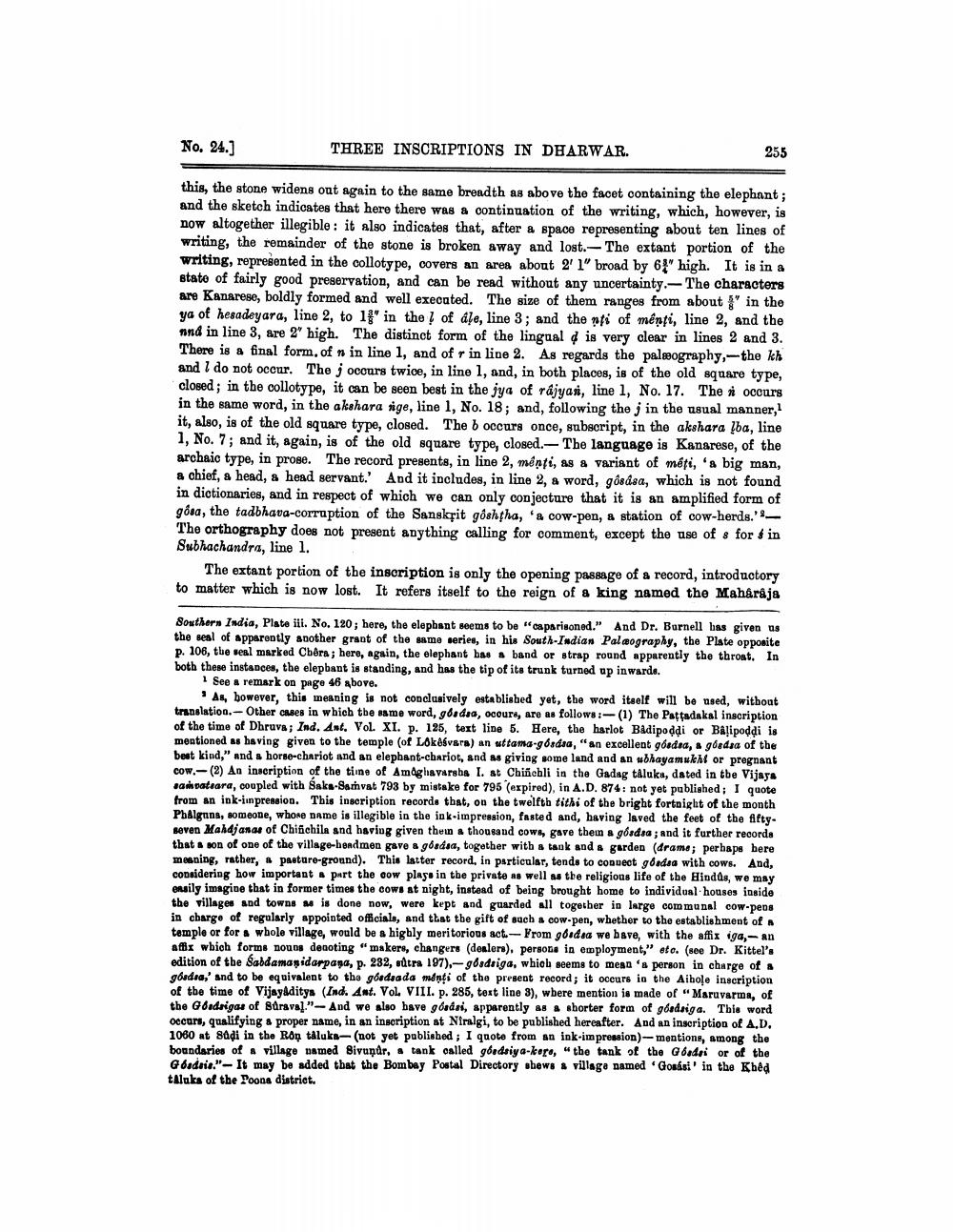________________
No. 24.]
THREE INSCRIPTIONS IN DHARWAR.
255
this, the stone widens out again to the same breadth as above the facet containing the elephant; and the sketch indicates that here there was a continuation of the writing, which, however, is now altogether illegible: it also indicates that, after a space representing about ten lines of writing, the remainder of the stone is broken away and lost. The extant portion of the writing, represented in the collotype, covers an area about 2' 1" broad by 6% high. It is in a state of fairly good preservation, and can be read without any uncertainty. The characters are Kanarese, boldly formed and well execated. The size of them ranges from about in the ya of hesadeyara, line 2, to 1f" in the of dļe, line 3; and the noti of menti, line 2, and the and in line 3, are 2" high. The distinct form of the lingual d is very clear in lines 2 and 3. There is a final form, of in line 1, and of r in line 2. As regards the palæography,-the kh and I do not occur. The j cours twice, in line 1, and, in both places, is of the old square type, closed; in the collotype, it can be seen best in the jya of rajyari, line 1, No. 17. The occurs in the same word, in the akshara nge, line 1, No. 18; and, following the j in the usual manner, it, also, is of the old square type, closed. The b occurs once, subscript, in the akshara {ba, line 1, No. 7; and it, again, is of the old square type, closed. - The language is Kanarese, of the archaic type, in prose. The record presents, in line 2, menti, as a variant of méti, 'a big man, a chief, a head, a head servant. And it includes, in line 2, a word, gôsdsa, which is not found in dictionaries, and in respect of which we can only conjecture that it is an amplified form of goa, the tadbhava-corruption of the Sanskrit gôshtha, 'a cow-pen, & station of cow-herds.' The orthography does not present anything calling for comment, except the use of s for & in Subhachandra, line 1.
The extant portion of the inscription is only the opening passage of a record, introductory to matter which is now lost. It refers itself to the reign of a king named the Maharaja
Southern India, Plate ill. No. 120; here, the elephant seems to be "caparisoned." And Dr. Barnell has given us the seal of apparently another grant of the same series, in his South Indian Palæography, the Plate opposite p. 106, the real marked Cbêra; here, again, the elephant bas a band or strap round apparently the throat. In both these instances, the elepbant is standing, and has the tip of its trunk turned up inwarde.
See a remark on page 46 above.
As, however, this meaning is not conclusively established yet, the word itself will be used, without translation.- Other cases in which the same word, goodsa, coura, are as follows:-(1) The Pattadakal inscription of the time of Dhruva; Ind. Ant. Vol. XI. p. 125, text line 5. Here, the harlot Bidipoddi or Baļipoddi is mentioned as having given to the temple (of Lokesvera) an ut tama-gordea, "an excellent góedia, a gosdea of the beat kind," and a horse-chariot and an elephant-chariot, and es giving some land and an ubhayamukht or pregnant cow.-(2) An inscription of the tiine of Amaghavarsha I. st Chiñehli in the Gadag taluka, dsted in tbe Vijaya sam pateara, coupled with Baka-Samvat 793 by mistake for 795 (expired), in A.D. 874: not yet published; I quote from an ink-impression. This inscription records that, on the twelfth tithi of the bright fortnight of the month PhAlguns, someone, whose name is illegible in the ink-impression, fasted and, having laved the feet of the Aftyseven Mahdjana of Chifichila and having given them a thousand cows, gave them a goodsa; and it further records that a son of one of the village-hendmen gave a godsa, together with a tack and & garden (drame; perhaps bere meaning, rather, a pastore-ground). This letter record, in particular, tends to connect goadia with cows. And, considering how important part the cow plage in the private as well as the religious life of the Hindds, we may easily imagine that in former times the cows at night, instead of being brought home to individual houses inside the villages and towns M is done now, were kept and guarded all together in large communal cow-pens in charge of regularly appointed officials, and that the gift of such a cow-pen, whether to the establishment of a temple or for a whole village, would be a highly meritorious act. From goodsa we bave, with the affix iga,- an affix which forms nous deuoting "makers, changers (dealers), persona in employment," eto. (see Dr. Kittel's edition of tbe Šabda manidarpana, p. 232, tra 197).-gósdriga, which seems to mesn's person in charge of a goudia,' and to be equivalent to the goodsada monti of the present record; it occurs in the Aibole inscription of the time of Vijayaditys (Ind. Ant. VoL VIII. p. 285, text line 3), wbere mention is made of "Maruvarma, of the Gdadrigae of Suraval."- And we also bave goodsi, apparently as a shorter form of goodsige. This word occurs, qualifying a proper name, in an inscription at Niralgi, to be published hereafter. And an inscription of A.D. 1060 at sadi in the Roq taluka-(not yet published; I quote from an ink-impression)-mentions, among the boundaries of A village named Bivunar, # tank called goudsiya-kore, the tank of the Gbadai or of the G bidaia."- It may be added that the Bombay Postal Directory shews & village named 'Gosás!' in the Khed tAluks of the Poona district.




